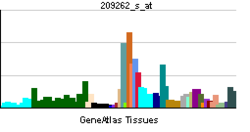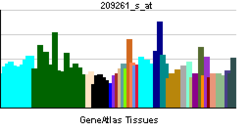- V-erbA-related gene
-
V-erbA-related protein 2 (EAR-2) also known as NR2F6 (nuclear receptor subfamily 2 group F member 6) is a protein that in humans is encoded by the NR2F6 gene.[1] V-erbA-related protein 2 is a member of the nuclear receptor family of intracellular transcription factors.
Contents
Function
Comparatively little is known about ear-2, but is has been shown to function as a coregulator of other nuclear receptors.[2][3]
Nr2f6 knockout mice show defects in development of the locus ceruleus.[4]
Interactions
V-erbA-related gene has been shown to interact with:
References
- ^ Miyajima N, Kadowaki Y, Fukushige S, Shimizu S, Semba K, Yamanashi Y, Matsubara K, Toyoshima K, Yamamoto T (1988). "Identification of two novel members of erbA superfamily by molecular cloning: the gene products of the two are highly related to each other". Nucleic Acids Res. 16 (23): 11057–74. doi:10.1093/nar/16.23.11057. PMC 338996. PMID 2905047. http://www.pubmedcentral.nih.gov/articlerender.fcgi?tool=pmcentrez&artid=338996.
- ^ a b Zhu XG, Park KS, Kaneshige M, Bhat MK, Zhu Q, Mariash CN, McPhie P, Cheng SY (2000). "The orphan nuclear receptor Ear-2 is a negative coregulator for thyroid hormone nuclear receptor function". Mol. Cell. Biol. 20 (7): 2604–18. doi:10.1128/MCB.20.7.2604-2618.2000. PMC 85476. PMID 10713182. http://www.pubmedcentral.nih.gov/articlerender.fcgi?tool=pmcentrez&artid=85476.
- ^ Liu X, Huang X, Sigmund CD (2003). "Identification of a nuclear orphan receptor (Ear2) as a negative regulator of renin gene transcription". Circ. Res. 92 (9): 1033–40. doi:10.1161/01.RES.0000071355.82009.43. PMID 12690040.
- ^ Warnecke M, Oster H, Revelli JP, Alvarez-Bolado G, Eichele G (March 2005). "Abnormal development of the locus coeruleus in Ear2(Nr2f6)-deficient mice impairs the functionality of the forebrain clock and affects nociception". Genes Dev. 19 (5): 614–25. doi:10.1101/gad.317905. PMC 551581. PMID 15741322. http://www.pubmedcentral.nih.gov/articlerender.fcgi?tool=pmcentrez&artid=551581.
- ^ Avram D, Ishmael JE, Nevrivy DJ, Peterson VJ, Lee SH, Dowell P, Leid M (May 1999). "Heterodimeric interactions between chicken ovalbumin upstream promoter-transcription factor family members ARP1 and ear2". J. Biol. Chem. 274 (20): 14331–6. doi:10.1074/jbc.274.20.14331. PMC 2823254. PMID 10318855. http://www.pubmedcentral.nih.gov/articlerender.fcgi?tool=pmcentrez&artid=2823254.
Further reading
- Bähler M, Kehrer I, Gordon L, et al. (1997). "Physical mapping of human myosin-IXB (MYO9B), the human orthologue of the rat myosin myr 5, to chromosome 19p13.1.". Genomics 43 (1): 107–9. doi:10.1006/geno.1997.4776. PMID 9226381.
- Avram D, Ishmael JE, Nevrivy DJ, et al. (1999). "Heterodimeric interactions between chicken ovalbumin upstream promoter-transcription factor family members ARP1 and ear2.". J. Biol. Chem. 274 (20): 14331–6. doi:10.1074/jbc.274.20.14331. PMC 2823254. PMID 10318855. http://www.pubmedcentral.nih.gov/articlerender.fcgi?tool=pmcentrez&artid=2823254.
- Zhang Y, Dufau ML (2000). "Nuclear orphan receptors regulate transcription of the gene for the human luteinizing hormone receptor.". J. Biol. Chem. 275 (4): 2763–70. doi:10.1074/jbc.275.4.2763. PMID 10644740.
- Zhu XG, Park KS, Kaneshige M, et al. (2000). "The orphan nuclear receptor Ear-2 is a negative coregulator for thyroid hormone nuclear receptor function.". Mol. Cell. Biol. 20 (7): 2604–18. doi:10.1128/MCB.20.7.2604-2618.2000. PMC 85476. PMID 10713182. http://www.pubmedcentral.nih.gov/articlerender.fcgi?tool=pmcentrez&artid=85476.
- Strausberg RL, Feingold EA, Grouse LH, et al. (2003). "Generation and initial analysis of more than 15,000 full-length human and mouse cDNA sequences.". Proc. Natl. Acad. Sci. U.S.A. 99 (26): 16899–903. doi:10.1073/pnas.242603899. PMC 139241. PMID 12477932. http://www.pubmedcentral.nih.gov/articlerender.fcgi?tool=pmcentrez&artid=139241.
- Liu X, Huang X, Sigmund CD (2003). "Identification of a nuclear orphan receptor (Ear2) as a negative regulator of renin gene transcription.". Circ. Res. 92 (9): 1033–40. doi:10.1161/01.RES.0000071355.82009.43. PMID 12690040.
- Beausoleil SA, Jedrychowski M, Schwartz D, et al. (2004). "Large-scale characterization of HeLa cell nuclear phosphoproteins.". Proc. Natl. Acad. Sci. U.S.A. 101 (33): 12130–5. doi:10.1073/pnas.0404720101. PMC 514446. PMID 15302935. http://www.pubmedcentral.nih.gov/articlerender.fcgi?tool=pmcentrez&artid=514446.
- Gerhard DS, Wagner L, Feingold EA, et al. (2004). "The status, quality, and expansion of the NIH full-length cDNA project: the Mammalian Gene Collection (MGC).". Genome Res. 14 (10B): 2121–7. doi:10.1101/gr.2596504. PMC 528928. PMID 15489334. http://www.pubmedcentral.nih.gov/articlerender.fcgi?tool=pmcentrez&artid=528928.
External links
Transcription factors and intracellular receptors (1) Basic domains (1.1) Basic leucine zipper (bZIP)Activating transcription factor (AATF, 1, 2, 3, 4, 5, 6, 7) · AP-1 (c-Fos, FOSB, FOSL1, FOSL2, JDP2, c-Jun, JUNB, JUND) · BACH (1, 2) · BATF · BLZF1 · C/EBP (α, β, γ, δ, ε, ζ) · CREB (1, 3, L1) · CREM · DBP · DDIT3 · GABPA · HLF · MAF (B, F, G, K) · NFE (2, L1, L2, L3) · NFIL3 · NRL · NRF (1, 2, 3) · XBP1(1.2) Basic helix-loop-helix (bHLH)ATOH1 · AhR · AHRR · ARNT · ASCL1 · BHLHB2 · BMAL (ARNTL, ARNTL2) · CLOCK · EPAS1 · FIGLA · HAND (1, 2) · HES (5, 6) · HEY (1, 2, L) · HES1 · HIF (1A, 3A) · ID (1, 2, 3, 4) · LYL1 · MESP2 · MXD4 · MYCL1 · MYCN · Myogenic regulatory factors (MyoD, Myogenin, MYF5, MYF6) · Neurogenins (1, 2, 3) · NeuroD (1, 2) · NPAS (1, 2, 3) · OLIG (1, 2) · Pho4 · Scleraxis · SIM (1, 2) · TAL (1, 2) · Twist · USF1(1.3) bHLH-ZIP(1.4) NF-1(1.5) RF-X(1.6) Basic helix-span-helix (bHSH)(2) Zinc finger DNA-binding domains (2.1) Nuclear receptor (Cys4)subfamily 1 (Thyroid hormone (α, β), CAR, FXR, LXR (α, β), PPAR (α, β/δ, γ), PXR, RAR (α, β, γ), ROR (α, β, γ), Rev-ErbA (α, β), VDR)
subfamily 2 (COUP-TF (I, II), Ear-2, HNF4 (α, γ), PNR, RXR (α, β, γ), Testicular receptor (2, 4), TLX)
subfamily 3 (Steroid hormone (Androgen, Estrogen (α, β), Glucocorticoid, Mineralocorticoid, Progesterone), Estrogen related (α, β, γ))
subfamily 4 NUR (NGFIB, NOR1, NURR1) · subfamily 5 (LRH-1, SF1) · subfamily 6 (GCNF) · subfamily 0 (DAX1, SHP)(2.2) Other Cys4(2.3) Cys2His2General transcription factors (TFIIA, TFIIB, TFIID, TFIIE (1, 2), TFIIF (1, 2), TFIIH (1, 2, 4, 2I, 3A, 3C1, 3C2))
ATBF1 · BCL (6, 11A, 11B) · CTCF · E4F1 · EGR (1, 2, 3, 4) · ERV3 · GFI1 · GLI-Krüppel family (1, 2, 3, REST, S2, YY1) · HIC (1, 2) · HIVEP (1, 2, 3) · IKZF (1, 2, 3) · ILF (2, 3) · KLF (2, 3, 4, 5, 6, 7, 8, 9, 10, 11, 12, 13, 14, 15, 17) · MTF1 · MYT1 · OSR1 · PRDM9 · SALL (1, 2, 3, 4) · SP (1, 2, 4, 7, 8) · TSHZ3 · WT1 · Zbtb7 (7A, 7B) · ZBTB (16, 17, 20, 32, 33, 40) · zinc finger (3, 7, 9, 10, 19, 22, 24, 33B, 34, 35, 41, 43, 44, 51, 74, 143, 146, 148, 165, 202, 217, 219, 238, 239, 259, 267, 268, 281, 295, 300, 318, 330, 346, 350, 365, 366, 384, 423, 451, 452, 471, 593, 638, 644, 649, 655)(2.4) Cys6(2.5) Alternating composition(3) Helix-turn-helix domains (3.1) HomeodomainARX · CDX (1, 2) · CRX · CUTL1 · DBX (1, 2) · DLX (3, 4, 5) · EMX2 · EN (1, 2) · FHL (1, 2, 3) · HESX1 · HHEX · HLX · Homeobox (A1, A2, A3, A4, A5, A7, A9, A10, A11, A13, B1, B2, B3, B4, B5, B6, B7, B8, B9, B13, C4, C5, C6, C8, C9, C10, C11, C12, C13, D1, D3, D4, D8, D9, D10, D11, D12, D13) · HOPX · IRX (1, 2, 3, 4, 5, 6, MKX) · LMX (1A, 1B) · MEIS (1, 2) · MEOX2 · MNX1 · MSX (1, 2) · NANOG · NKX (2-1, 2-2, 2-3, 2-5, 3-1, 3-2, 6-1, 6-2) · NOBOX · PBX (1, 2, 3) · PHF (1, 3, 6, 8, 10, 16, 17, 20, 21A) · PHOX (2A, 2B) · PITX (1, 2, 3) · POU domain (PIT-1, BRN-3: A, B, C, Octamer transcription factor: 1, 2, 3/4, 6, 7, 11) · OTX (1, 2) · PDX1 · SATB2 · SHOX2 · VAX1 · ZEB (1, 2)(3.2) Paired box(3.3) Fork head / winged helix(3.4) Heat Shock Factors(3.5) Tryptophan clusters(3.6) TEA domain(4) β-Scaffold factors with minor groove contacts (4.1) Rel homology region(4.2) STAT(4.3) p53(4.4) MADS box(4.6) TATA binding proteins(4.7) High-mobility group(4.10) Cold-shock domainCSDA, YBX1(4.11) Runt(0) Other transcription factors (0.2) HMGI(Y)(0.3) Pocket domain(0.6) MiscellaneousCategories:- Human proteins
- Chromosome 19 gene stubs
- Intracellular receptors
- Transcription factors
Wikimedia Foundation. 2010.


